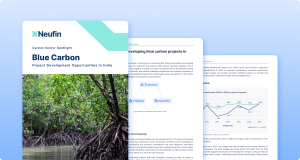Blue carbon has become a prominent phrase in recent years due to its significant role in mitigating climate change. Coastal and marine habitats sequester and store carbon dioxide at remarkable rates, offering a nature-based solution to offset carbon emissions. Beyond carbon sequestration, blue carbon ecosystems (mangroves, sea-grasses, and salt marshes) also provide coastal protection, support biodiversity, sustain fisheries, and bolster the resilience of coastal communities in the face of climate-related challenges. Investing in blue carbon ecosystems can offer environmental returns that are exponentially higher than those from other nature-based solutions such as reforestation and peatland restoration.

These ecosystems are strong contenders for conservation financing because they have suffered considerable historical losses and remain threatened globally. The loss of habitat has historically been a major source of carbon emissions and will continue to be so in the future. For example, if the ongoing loss of mangroves persists, it is estimated that nearly 3400 Gigatons of CO2e could be released by 2100, including foregone soil carbon sequestration. However, despite the perceived environmental benefit and return on investment being positive, few blue carbon projects exist and even fewer have been registered in the voluntary carbon market. This remains a function of several economic, political, and scientific barriers.
This report explores the investment outlook towards blue carbon ecosystems in the context of the voluntary carbon markets. We examine the challenges that inhibit the growth of blue carbon projects in India and propose practical solutions that act as a guide for both, investors and project developers looking to invest time and resources in building such projects. In the Indian context, there is a lot to gain from investing in the conservation and restoration of these coastal ecosystems. However, action is impeded by a complex and hard-to-navigate regulatory apparatus. To reconcile the information asymmetry, the report provides a comprehensive overview of Indian laws and policies that have a bearing on the implementation and execution of blue carbon projects. It also provides an in-depth overview of the steps involved in developing a blue carbon project in the voluntary carbon market and highlights best practices extrapolated from the learnings from existing blue carbon projects around the world. The report highlights considerations that all project developers and investors must make before investing in a blue carbon project.
Read our full report to understand the opportunities and barriers to developing blue carbon projects in the voluntary carbon market along with actionable solutions.
